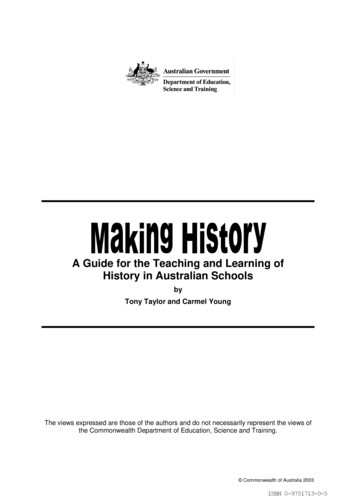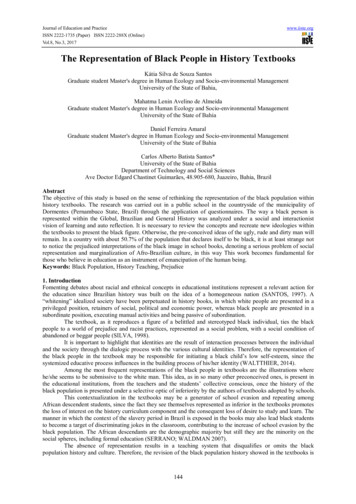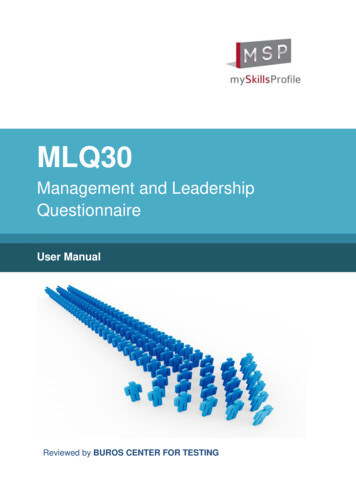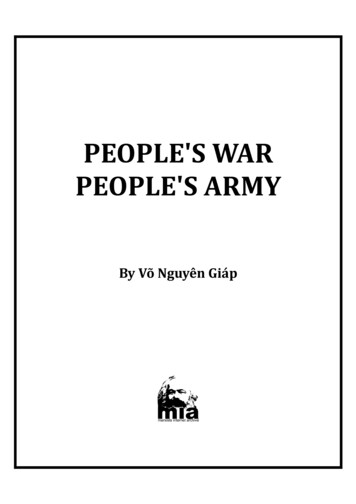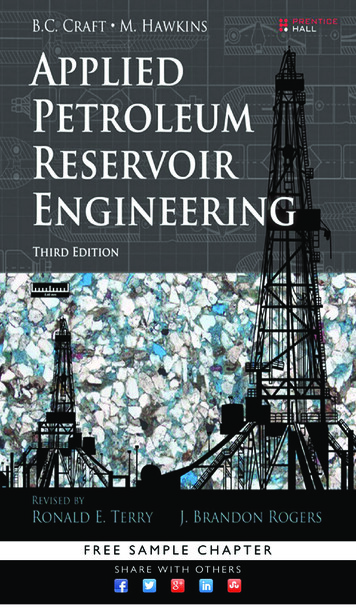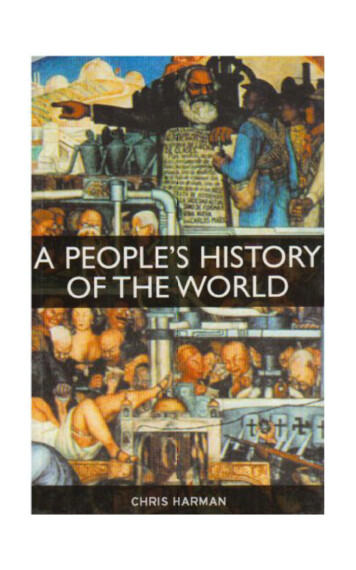
Transcription
A people’s history ofthe world
A people’shistory of theworldChris HarmanLondon, Chicago and Sydney
A People’s History of the World – Chris HarmanFirst published 1999Reprinted 2002Bookmarks Publications Ltd, c/o 1 Bloomsbury Street, London WC1B 3QE, EnglandBookmarks, PO Box 16085, Chicago, Illinois 60616, USABookmarks, PO Box A338, Sydney South, NSW 2000, AustraliaCopyright Bookmarks Publications LtdISBN 1 898876 55 XPrinted by Interprint Limited, MaltaCover by Sherborne DesignBookmarks Publications Ltd is linked to an international grouping of socialistorganisations: Australia: International Socialist Organisation, PO Box A338, Sydney South.iso@iso.org.au Austria: Linkswende, Postfach 87, 1108 Wien. linkswende@yahoo.com Britain: Socialist Workers Party, PO Box 82, London E3 3LH.enquiries@swp.org.uk Canada: International Socialists, PO Box 339, Station E, Toronto, Ontario M6H 4E3.iscanada@on.aibn.com Cyprus: Ergatiki Demokratia, PO Box 7280, Nicosia. wd@workersdemocracy.net Czech Republic: Socialisticka Solidarita, PO Box 1002, 11121 Praha 1.socsol@email.cz Denmark: Internationale Socialister, PO Box 5113, 8100 Aarhus C.intsoc@socialister.dk Finland: Sosialistiliitto, PL 288, 00171 Helsinki. info@sosialistiliitto.org France: Socialisme par en bas, BP 15-94111, Arcueil Cedex. speb@mageos.com Germany: Linksruck, Postfach 304 183, 20359 Hamburg. info@linksruck.de Ghana: International Socialist Organisation, PO Box TF202, Trade Fair, Labadi,Accra. Greece: Sosialistiko Ergatiko Komma, c/o Workers Solidarity, PO Box 8161,Athens 100 10. sek@otenet.gr Holland: Internationale Socialisten, PO Box 92025, 1090AA Amsterdam.info@internationalesocialisten.org Ireland: Socialist Workers Party, PO Box 1648, Dublin 8. swp@clubi.ie Italy: Comunismo dal Basso, Leeder, CP Bologna, Succ 5. dalbasso@hotmail.com New Zealand: Socialist Workers Organisation, PO Box 13-685, Auckland.socialist-worker@pl.net Norway: Internasjonale Socialisterr, Postboks 9226, Grønland, 0134 Oslo.sarbeide@online.no Poland: Pracownicza Demokracja, PO Box 12, 01-900 Warszawa 118.pracdem@go2.pl Spain: En Lucha, Apartado 563, 08080 Barcelona. enlucha@hotmail.com United States: Left Turn, PO Box 445, New York, NY 10159-0445.left-turn@left-turn.org Uruguay: Izquierda Revolucionaria. ir@adinet.com.uy Zimbabwe: International Socialist Organisation, PO Box 6758, Harare.isozim@hotmail.com
ContentsIntroductioniPart one: The rise of class societiesPrologue: Before classChapter 1 The neolithic ‘revolution’Chapter 2 The first civilisationsChapter 3 The first class divisionsChapter 4 Women’s oppressionChapter 5 The first ‘Dark Ages’31017222932Part two: The ancient worldChapter 1 Iron and empiresChapter 2 Ancient IndiaChapter 3 The first Chinese empiresChapter 4 The Greek city statesChapter 5 Rome’s rise and fallChapter 6 The rise of Christianity454854637187Part three: The ‘Middle Ages’Chapter 1 The centuries of chaosChapter 2 China: the rebirth of the empireChapter 3 Byzantium: the living fossilChapter 4 The Islamic revolutionsChapter 5 The African civilisationsChapter 6 European feudalism103106117123136140
Part four: The great transformationChapter 1 The conquest of the New SpainChapter 2 Renaissance to ReformationChapter 3 The birth pangs of a new orderChapter 4 The last flowering of Asia’s empires161172194219Part five: The spread of the new orderChapter 1 A time of social peaceChapter 2 From superstition to scienceChapter 3 The EnlightenmentChapter 4 Slavery and wage slaveryChapter 5 Slavery and racismChapter 6 The economics of ‘free labour’233237242247249257Part six: The world turned upside downChapter 1 American prologueChapter 2 The French RevolutionChapter 3 Jacobinism outside FranceChapter 4 The retreat of reasonChapter 5 The industrial revolutionChapter 6 The birth of MarxismChapter 7 1848Chapter 8 The American Civil WarChapter 9 The conquest of the EastChapter 10 The Japanese exceptionChapter 11 Storming heaven:The Paris Commune265277303315318326335345355365368
Part seven: The century of hope and horrorChapter 1 The world of capitalChapter 2 World war and world revolutionChapter 3 Europe in turmoilChapter 4 Revolt in the colonial worldChapter 5 The ‘Golden Twenties’Chapter 6 The great slumpChapter 7 Strangled hope: 1934-36Chapter 8 Midnight in the centuryChapter 9 The Cold WarChapter 10 The new world disorder379405430449463469491510543577Conclusion: Illusion of the epoch605Notes621Glossary663Further Reading687Index695
Chris Harman is the editor of Socialist Worker and a leadingmember of the Socialist Workers Party in Britain. He is theauthor of many articles, pamphlets and books including ClassStruggles in Eastern Europe, Explaining the Crisis, Economics of theMadhouse, How Marxism Works and The Lost Revolution:Germany 1918 to 1923.
IntroductionWho built Thebes of the seven gates?In the books you will find the names of kings.Did the kings haul up the lumps of rock?And Babylon, many times demolishedWho raised it up so many times? In what housesOf gold-glittering Lima did the builders live?Where, the evening that the Wall of China was finishedDid the masons go? Great RomeIs full of triumphal arches. Who erected them? Over whomDid the Caesars triumph? Had Byzantium, much praised in songOnly palaces for its inhabitants? Even in fabled AtlantisThe night the ocean engulfed itThe drowning still bawled for their slaves.The young Alexander conquered India.Was he alone?Caesar beat the Gauls.Did he not have even a cook with him?Philip of Spain wept when his armadaWent down. Was he the only one to weep?Frederick the Second won the Seven Years War. WhoElse won it?Every page a victory.Who cooked the feast for the victors?Every ten years a great man.Who paid the bill?So many reports.So many questions.‘Questions from a Worker who Reads’ by Bertolt Brechti
A PEOPLE’S HISTORY OF THE WORLDThe questions raised in Brecht’s poem are crying out for answers. Providing them should be the task of history. It should not be regardedas the preserve of a small group of specialists, or a luxury for those whocan afford it. History is not ‘bunk’, as claimed by Henry Ford, pioneerof mass motor car production, bitter enemy of trade unionism and earlyadmirer of Adolf Hitler.History is about the sequence of events that led to the lives welead today. It is the story of how we came to be ourselves. Understanding it is the key to finding out if and how we can further changethe world in which we live. ‘He who controls the past controls thefuture,’ is one of the slogans of the totalitarians who control the statein George Orwell’s novel 1984. It is a slogan always taken seriously bythose living in the palaces and eating the banquets described in Brecht’s‘Questions’.Some 22 centuries ago a Chinese emperor decreed the deathpenalty for those who ‘used the past to criticise the present’. TheAztecs attempted to destroy records of previous states when they conquered the Valley of Mexico in the 15th century, and the Spanish attempted to destroy all Aztec records when they in turn conquered theregion in the 1620s.Things have not been all that different in the last century. Challenging the official historians of Stalin or Hitler meant prison, exileor death. Only 30 years ago Spanish historians were not allowed todelve into the bombing of the Basque city of Guernica, or Hungarian historians to investigate the events of 1956. More recently, friendsof mine in Greece faced trial for challenging the state’s version ofhow it annexed much of Macedonia before the First World War.Overt state repression may seem relatively unusual in Western industrial countries. But subtler methods of control are ever-present. AsI write, a New Labour government is insisting schools must stressBritish history and British achievements, and that pupils must learnthe name and dates of great Britons. In higher education, the historians most in accord with establishment opinions are still the ones whoreceive honours, while those who challenge such opinions are keptout of key university positions. ‘Compromise, compromise’, remains‘the way for you to rise.’Since the time of the first Pharaohs (5,000 years ago) rulers havepresented history as being a list of ‘achievements’ by themselves andtheir forebears. Such ‘Great Men’ are supposed to have built citiesii
INTRODUCTIONand monuments, to have brought prosperity, to have been responsible for great works or military victories—and, conversely, ‘EvilMen’ are supposed to be responsible for everything bad in the world.The first works of history were lists of monarchs and dynasties knownas ‘King Lists’. Learning similar lists remained a major part of historyas taught in the schools of Britain 40 years ago. New Labour—andthe Tory opposition—seem intent on reimposing it.For this version of history, knowledge consists simply in being ableto memorise such lists, in the fashion of the ‘Memory Man’ or the Mastermind contestant. It is a Trivial Pursuits version of history that provides no help in understanding either the past or the present.There is another way of looking at history, in conscious oppositionto the ‘Great Man’ approach. It takes particular events and tells theirstory, sometimes from the point of view of the ordinary participants.This can fascinate people. There are large audiences for televisionprogrammes—even whole channels—which make use of such material. School students presented with it show an interest rare with theold ‘kings, dates and events’ method.But such ‘history from below’ can miss out something of great importance, the interconnection of events.Simply empathising with the people involved in one event cannot,by itself, bring you to understand the wider forces that shaped theirlives, and still shape ours. You cannot, for instance, understand therise of Christianity without understanding the rise and fall of theRoman Empire. You cannot understand the flowering of art during theRenaissance without understanding the great crises of European feudalism and the advance of civilisation on continents outside Europe.You cannot understand the workers’ movements of the 19th centurywithout understanding the industrial revolution. And you cannotbegin to grasp how humanity arrived at its present condition withoutunderstanding the interrelation of these and many other events.The aim of this book is to try to provide such an overview.I do not pretend to provide a complete account of human history.Missing are many personages and many events which are essential toa detailed history of any period. But you do not need to know aboutevery detail of humanity’s past to understand the general pattern thathas led to the present.It was Karl Marx who provided an insight into this general pattern.He pointed out that human beings have only been able to survive oniii
A PEOPLE’S HISTORY OF THE WORLDthis planet through cooperative effort to make a livelihood, and thatevery new way of making such a livelihood has necessitated changesin their wider relationships with each other. Changes in what he called‘the forces of production’ are associated with changes in ‘the relationsof production’, and these eventually transform the wider relationshipsin society as a whole.Such changes do not, however, occur in a mechanical way. At eachpoint human beings make choices whether to proceed along one pathor another, and fight out these choices in great social conflicts. Beyonda certain point in history, how people make their choices is connectedto their class position. The slave is likely to make a different choiceto the slave-owner, the feudal artisan to the feudal lord. The greatstruggles over the future of humanity have involved an element ofclass struggle. The sequence of these great struggles provides the skeleton round which the rest of history grows.This approach does not deny the role of individuals or the ideas theypropagate. What it does do is insist that the individual or idea can onlyplay a certain role because of the preceding material development ofsociety, of the way people make their livelihoods, and of the structureof classes and states. The skeleton is not the same as the living body.But without the skeleton the body would have no solidity and couldnot survive. Understanding the material ‘basis’ of history is an essential, but not sufficient, precondition for understanding everything else.This book, then, attempts to provide an introductory outline toworld history, and no more than that. But it is an outline which, Ihope, will help some people come to terms with both the past and thepresent.In writing it, I have been aware throughout that I have to face upto two prejudices.One is the idea that the key features of successive societies andhuman history have been a result of an ‘unchanging’ human nature. Itis a prejudice that pervades academic writing, mainstream journalismand popular culture alike. Human beings, we are told, have alwaysbeen greedy, competitive and aggressive, and that explains horrors likewar, exploitation, slavery and the oppression of women. This ‘caveman’ image is meant to explain the bloodletting on the Western Frontin one world war and the Holocaust in the other. I argue very differently. ‘Human nature’ as we know it today is a product of our history,not its cause. Our history has involved the moulding of different humaniv
INTRODUCTIONnatures, each displacing the one that went before through great economic, political and ideological battles.The second prejudice, much promulgated in the last decade, isthat although human society may have changed in the past, it will doso no more.An adviser to the US State Department, Francis Fukuyama, received international acclaim when he spelt out this message in 1990.We were witnessing no less than ‘the end of history’, he declared inan article that was reproduced in scores of languages in newspapersright across the world. Great social conflicts and great ideologicalstruggles were a thing of the past—and a thousand newspaper editorsand television presenters agreed.Anthony Giddens, director of the London School of Economics andcourt sociologist to Britain’s New Labour prime minister, repeated thesame message in 1998 in his much hyped but little read book, The ThirdWay. We live in a world, he wrote, ‘where there are no alternatives tocapitalism.’ He was accepting and repeating a widespread assumption.It is an unsustainable assumption.Capitalism as a way of organising the whole production of a country is barely three or four centuries old. As a way of organising thewhole production of the world, it is at most 150 years old. Industrialcapitalism, with its huge conurbations, widespread literacy and universal dependence on markets, has only taken off in vast tracts ofthe globe in the last 50 years. Yet humans of one sort or another havebeen on the earth for over a million years, and modern humans forover 100,000 years. It would be remarkable indeed if a way of runningthings that has existed for less than 0.5 percent of our species’ lifespan were to endure for the rest of it—unless that lifespan is going tobe very short indeed. All the writings of Fukuyama and Giddens dois confirm that Karl Marx was right about at least one thing, in notingthat ‘for the bourgeoisie there has been history and is no more’.The recent past of our species had not been some smooth upwardpath of progress. It has been marked by repeated convulsions, horrificwars, bloody civil wars, violent revolutions and counter-revolutions.Times when it seemed that the lot of the mass of humanity was boundto improve have almost invariably given way to decades or even centuries of mass impoverishment and terrible devastation.It is true that through all these horrors there were important advances in the ability of humans to control and manipulate the forcesv
A PEOPLE’S HISTORY OF THE WORLDof nature. We have a vastly greater capacity to do so today than a thousand years ago. We live in a world in which natural forces should nolonger be able to make people starve or freeze to death, in which diseases which once terrified people should have been abolished for ever.But this in itself has not done away with the periodic devastationof hundred of millions of lives through hunger, malnutrition and war.The record of the 20th century shows that. It was the century inwhich industrial capitalism finally took over the whole world, so thateven the most remote peasant or herder now depends to some degreeon the market. It was also a century of war, butchery, deprivationand barbarity to match any in the past, so much so that the liberalphilosopher Isaiah Berlin described it as ‘the most terrible century inWestern history’. There was nothing in the last decades of the century to suggest things had magically improved for humanity as awhole. They saw the wholesale impoverishment of the former Eastern bloc, repeated famines and seemingly endless civil wars in differentparts of Africa, nearly half Latin America’s people living below thepoverty line, an eight year war between Iran and Iraq, and militaryonslaughts by coalitions of the world’s most powerful states against Iraqand Serbia.History has not ended, and the need to understand its main features is a great as ever. I have written this book in the hope that it willaid some people in this understanding.In doing so, I have necessarily relied on the efforts of numerousprevious works. The section on the rise of class society, for instance,would have been impossible without the writings of the great Australian archaeologist V Gordon Childe, whose own book What Happened in History bears reading over and over again, even if it is datedin certain important details. Similarly, the section on the medievalworld owes a big debt to the classic work of Marc Bloch and the outputof the French Annales school of historians, the sections on the early20th century to the works of Leon Trotsky, and on the later 20th century to the analyses of Tony Cliff. Readers with some knowledge of thematerial will notice a host of other influences, some quoted directlyand mentioned in the text or the end notes, others no less importantfor not receiving explicit acknowledgement. Names like ChristopherHill, Geoffrey de Ste Croix, Guy Bois, Albert Soboul, Edward Thompson, James McPherson and D D Kosambi spring to mind. I hope mybook will encourage people to read their work. For readers who want tovi
INTRODUCTIONfollow up particular periods, I include a brief list of further reading atthe end of the book.Dates are not the be-all and end-all of history, but the sequence ofevents is sometimes very important—and sometimes difficult for readers (and even writers!) to keep track of. For this reason, there is a briefchronology of the major events in a particular period at the beginningof each section. For a similar reason, I include at the end of the bookglossaries of names, places and unfamiliar terms. These are not comprehensive, but aim to help readers of any one section to make senseof references to people, events and geographical locations dealt withmore fully in others. Finally, I owe thanks to many people who haveassisted me in turning a raw manuscript into a finished book—to IanBirchall, Chris Bambery, Alex Callinicos, Charlie Hore, CharlieKimber, Lindsey German, Talat Ahmed, Hassan Mahamdallie, SethHarman, Paul McGarr, Mike Haynes, Tithi Bhattacharya, BarryPavier, John Molyneux, John Rees, Kevin Ovenden and Sam Ashmanfor reading all or parts of the manuscript, noticing numerous inaccuracies and sometimes forcing me to reassess what I had written.None of them, needless to say, are responsible either for the historical judgements I make at various places, nor for any factual errorsthat remain. I owe special thanks to Ian Taylor for editing the manuscript, and to Rob Hoveman for overseeing the production of the finalbook.vii
Part oneThe rise of classsocieties
Chronology2,800 BC. ‘Bronze Age’. Tendency forwomen to be seen as inferior to men.4 million years agoFirst apes to walk on two legs—Australopithecus.4,500 to 4,000 years ago (2500 to2000 BC)Growth of city states in Indus Valley.Sargon establishes first empire to uniteMiddle East. Building of stone rings inwestern Europe. Probably Nubiancivilisation south of Egypt.1.5 million to 0.5 million years agoClearly human species, Homo erectus,tools of stone, wood and bone. Early‘old Stone Age’.400,000 to 30,000 years agoNeanderthal humans in Europe andMiddle East—signs of culture andprobable use of language.4,000 years ago (around 2000 BC)‘Dark Age’—collapse of MesopotamianEmpire and of Egyptian ‘Old Kingdom’.Iron smelted in Asia Minor.150,000 years agoFirst ‘modern humans’ (Homo sapienssapiens), probably originated in Africa.Live by foraging (in small nomadicgroups without classes, states or sexualoppression). Middle ‘old Stone Age’.4,000 to 3,600 years ago (2000 to1600 BC)Rise of ‘Minoan’ civilisation in Crete.Revival of Egypt with ‘MiddleKingdom’ and of MesopotamianEmpire under Hammurabi. Urbanrevolution takes off in northern China.Mycenaean civilisation in Greece.80,000 to 14,000 years agoModern humans arrive Middle East(80,000 years ago); cross to Australia(40,000 years ago); arrive Europe (30,000years ago); establish Americas (14,000years ago). Late ‘old Stone Age’.3,600 years ago (1600 BC)Crisis in Egypt with collapse of ‘MiddleKingdom’ into ‘second intermediateperiod’. ‘Dark Age’ with collapse ofCretan, Indus and then Mycenaean,civilisations. Disappearance of literacy inthese areas. ‘Bronze Age’ in northernChina with Shang Empire.13,000 years agoClimate allows some humans to settlein villages a couple of hundred strongwhile continuing to live by foraging.‘Middle Stone Age’ (‘Mesolithic’).10,000 years agoFirst agricultural revolution.Domestication of plants and animals.Neolithic (‘new Stone Age’). Moreadvanced tools, use of pottery. Spreadof village-living. First systematic warbetween groups. Still no division intoclasses or states.3,000 years ago (1000 BC)Uxum civilisation in Ethiopia. Growthof Phoenician city states aroundMediterranean. ‘Urban revolution’ in‘Meso-America’ with Olmec cultureand in Andean region with Chavin.2,800 to 2,500 years ago (800 to500 BC)New civilisations arise in India, Greeceand Italy. Meroe in Nubia.7,000 years agoPlough begins to be used in Eurasia andAfrica. Agriculture reaches NWEurope. ‘Chieftainships’ among somegroups, but no classes or states.2,500 to 2,000 years ago (400 to1 BC)Olmec civilisation of Meso-Americainvents its own form of writing.6,000 to 5,000 years ago‘Urban revolution’ in river valleys ofMiddle East and Nile Valley, some useof copper.2,000 years ago (1st century AD)Rise of Teotihuacan in Valley ofMexico—probably biggest city inworld—despite having no use of hardmetals. Deserted after about 400 years.Followed by rise of civilisations ofMonte Alban and of Mayas in southernMexico and Guatemala.5,000 years ago (3000 BC)States emerge in Mesopotamia and‘Old Kingdom’ Egypt. First alphabets,bronze discovered, clear division intosocial classes, religious hierarchiesand temples. First pyramids in about2
PrologueBefore classThe world as we enter the 21st century is one of greed, of gross inequalities between rich and poor, of racist and national chauvinist prejudice, of barbarous practices and horrific wars. It is very easy to believethat this is what things have always been like and that, therefore, theycan be no different. Such a message is put across by innumerable writers and philosophers, politicians and sociologists, journalists and psychologists. They portray hierarchy, deference, greed and brutality as‘natural’ features of human behaviour. Indeed, there are some who wouldsee these as a feature throughout the animal kingdom, a ‘sociobiological’ imperative imposed by the alleged ‘laws’ of genetics.1 There are innumerable popular, supposedly ‘scientific’ paperbacks which propagatesuch a view—with talk of humans as ‘the naked ape’ (Desmond Morris),2the ‘killer imperative’ (Robert Ardrey),3 and, in a more sophisticatedform, as programmed by the ‘selfish gene’ (Richard Dawkins).4Yet such Flintstones caricatures of human behaviour are simply notborne out by what we now know about the lives our ancestors lived inthe innumerable generations before recorded history. A cumulation ofscientific evidence shows that their societies were not characterisedby competition, inequality and oppression. These things are, rather,the product of history, and of rather recent history. The evidence comesfrom archaeological findings about patterns of human behaviour worldwide until only about 5,000 years ago, and from anthropological studies of societies in different parts of the world which remained organisedalong similar lines until the 19th and earlier part of the 20th century.The anthropologist Richard Lee has summarised the findings:Before the rise of the state and the entrenchment of social inequality,people lived for millennia in small-scale kin-based social groups, inwhich the core institutions of economic life included collective orcommon ownership of land and resources, generalised reciprocity in thedistribution of food, and relatively egalitarian political relations.53
A PEOPLE’S HISTORY OF THE WORLDIn other words, people shared with and helped each other, with norulers and no ruled, no rich and no poor. Lee echoes the phrase used byFrederick Engels in the 1880s to describe this state of affairs, ‘primitivecommunism’. The point is of enormous importance. Our species (modernhumans, or Homo sapiens sapiens) is over 100,000 years old. For 95 percent of this time it has not been characterised at all by many of theforms of behaviour ascribed to ‘human nature’ today. There is nothingbuilt into our biology that makes present day societies the way they are.Our predicament as we face a new millennium cannot be blamed on it.The origins of our species go much further back into the mists oftime than 100,000 years. Our distant ancestors evolved out of a speciesof ape which lived some four or five million years ago in parts ofAfrica. For some unknown reason members of this species gave upliving in trees, as do our closest animal relatives, the common chimpanzee and the bonobo (often called the ‘pygmy chimpanzee’), andtook to walking upright. They were able to survive in their new terrain by cooperating more than any other species of mammal, working together to make rudimentary tools (as chimps sometimes do) todig up roots, reach high berries, gather grubs and insects, kill small animals and frighten off predators. The premium was on cooperationwith each other, not competition against one another. Those whocould not learn to adopt such forms of cooperative labour, and the newpatterns of mental behaviour that went with them, died out. Thosewho could survived and reproduced.Over millions of years this resulted in the evolution of a mammalwhose genetic inheritance was very different to that of other mammals.It lacked the highly specialised physical features which enable othermammals to defend themselves (large teeth or claws), to keep warm(thick fur) or to flee (long legs). Instead, early humans were geneticallyprogrammed for extreme flexibility in response to the world aroundthem—by being able to use their hands to hold and shape objects,being able to use their voices to communicate with each other, beingable to investigate, study and generalise about the world around them,and being able, through long years of child rearing, to pass on their skillsand learning. All this required the growth of large brains and the ability and desire to socialise. It also led to the development of a meansof communicating with each other (language) qualitatively differentto that of any other animals, and with it the ability to conceptualiseabout things which were not immediately present—that is, to become4
BEFORE CLASSconscious of the world around them and of themselves as beings withinit.6 The emergence of modern humans, probably in Africa some150,000 years ago, was the culmination of this process.7Over the next 90,000 years groups of our ancestors slowly spreadout from Africa to establish themselves in other parts of the globe, displacing other human species like the Neanderthals in the process.8 Byat least 60,000 years ago they had reached the Middle East. By 40,000years ago they had made their way to western Europe and also somehow managed to cross the band of sea separating the islands of southeast Asia from Australia. By 12,000 years ago, at the latest, they hadcrossed the frozen Bering Straits to reach the Americas, and werescattered across every continent except Antarctica. The small groupswhich established themselves in each location were often almostcompletely isolated from each other for many thousands of years(melting ice made the Bering Straits impassable and raised the sealevel to make the passage from south east Asia to Australia difficult).Their languages grew to be very different and each accumulated itsown set of knowledge and developed distinctive forms of social organisation and culture. Certain minor hereditary characteristicsbecame more marked among some than others (eye colour, hairiness,skin pigmentation and so on). But the genetic inheritance of the different groups remained extremely similar. Variations within eachgroup were always greater than variations between them. All of themwere equally capable of learning each other’s language, and all had thesame spread of intellectual aptitudes. The human species was separatedinto widely dispersed groupings. But it remained a single species. Howeach grouping developed depended not on anything specific about itsgenetic make up, but on how it adapted its manipulative skills andforms of cooperation to the needs of making a livelihood in its particular environment. It was the form taken by this adaption which underlay the different societies which emerged, each with its own distinctcustoms, attitude
Chapter 6 The economics of ‘free labour’ 257 Part six: The world turned upside down Chapter 1 American prologue 265 . The aim of this book is to try to provide such an overview. . A PEOPLE’S HISTORY OF THE WORLD. A PEOPLE’S HISTORY OF THE WORLD. INTRODUCTION. Part one The rise of classFile Size: 2MBPage Count: 700




